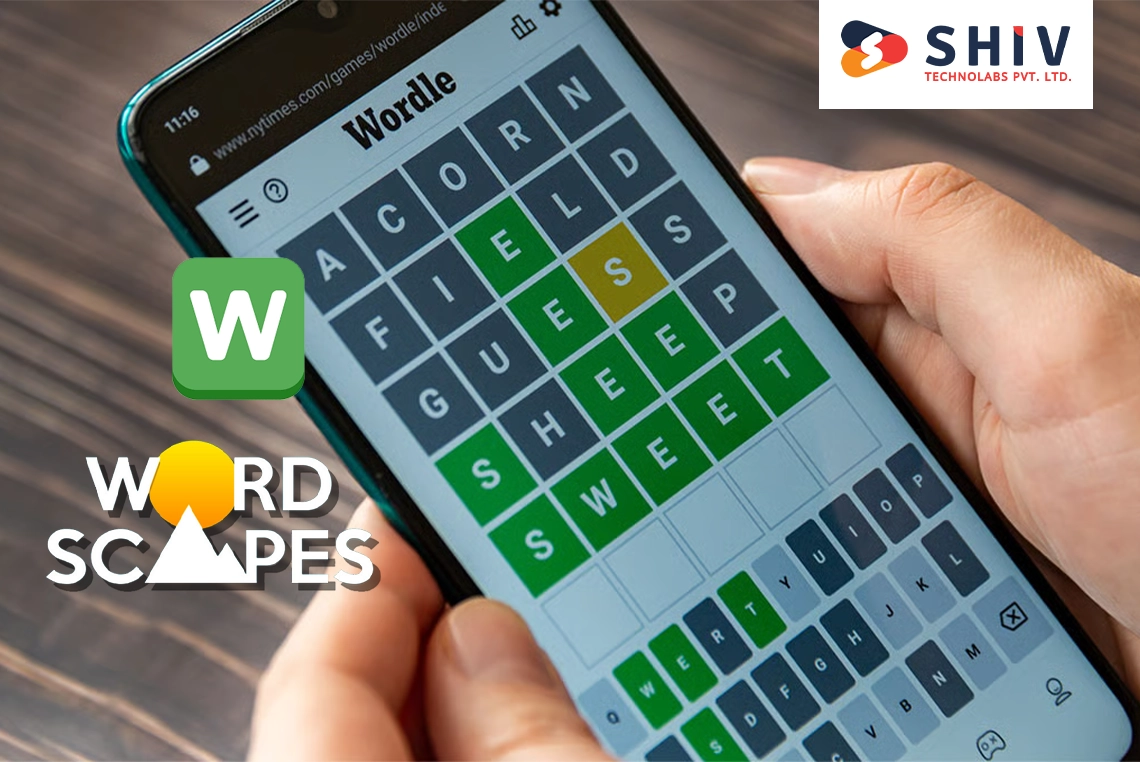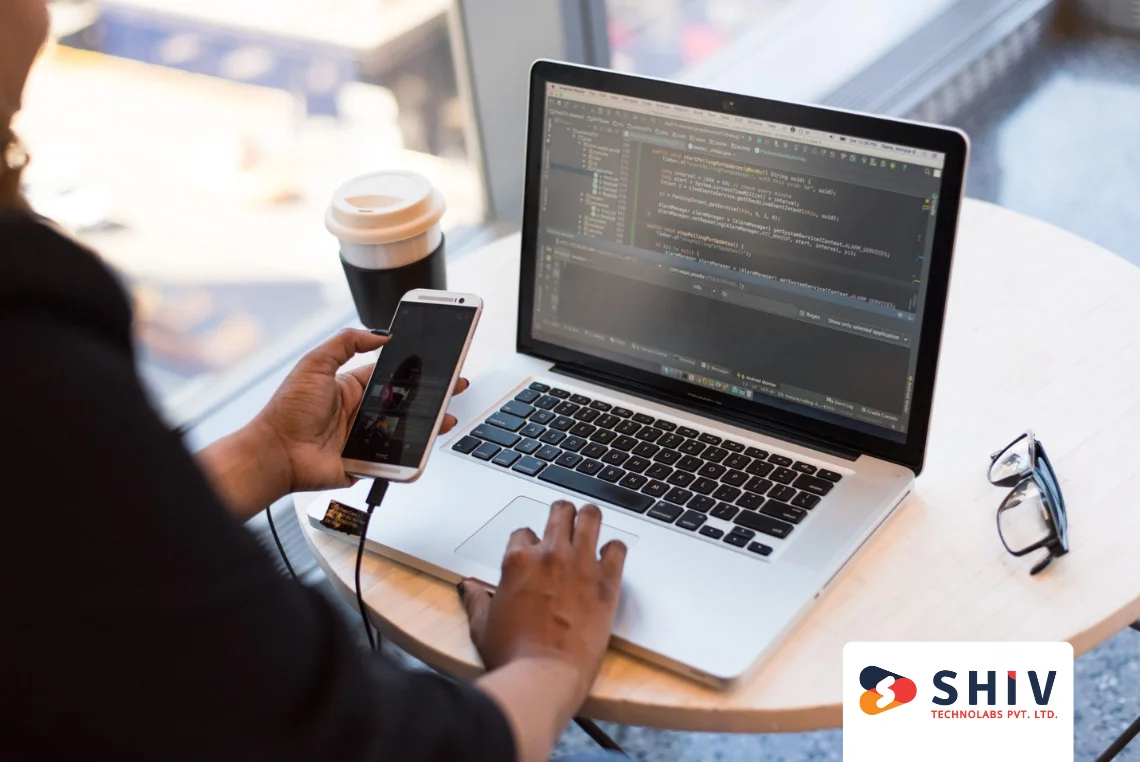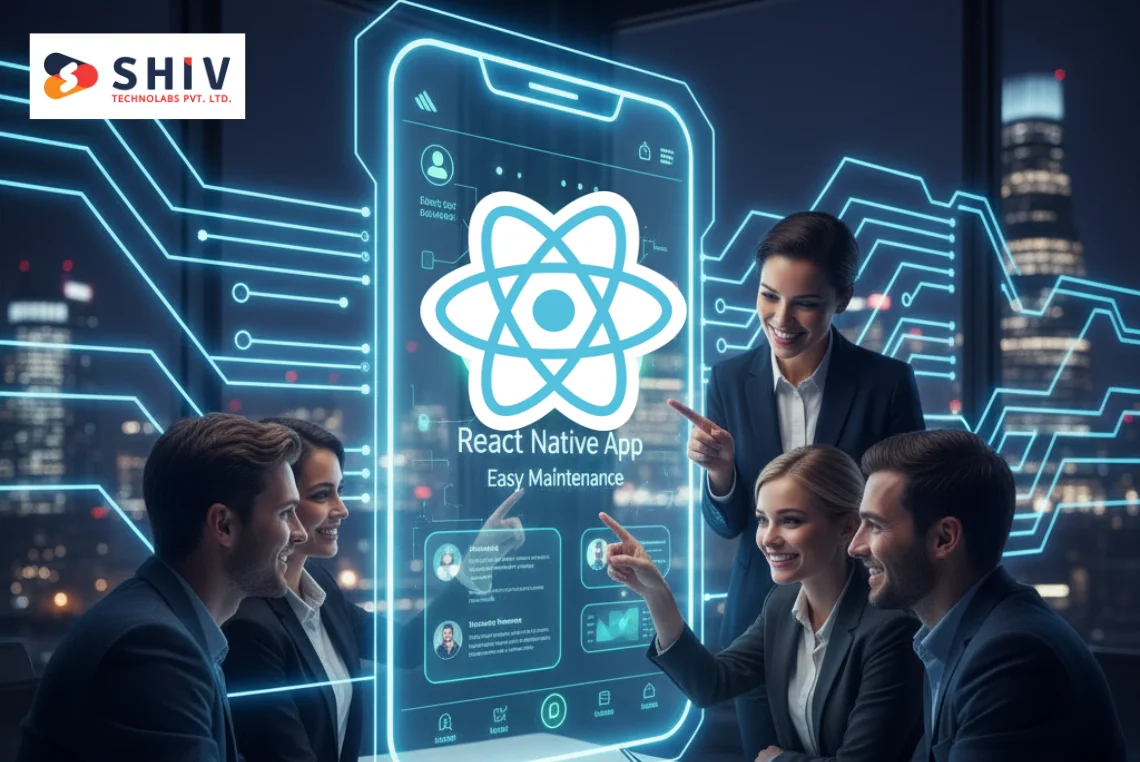Table of Contents
Word games keep gaining attention because they offer short, calm sessions that fit into daily routines. Players enjoy quick puzzles, steady progress, and simple rules that feel relaxing rather than stressful. Apps like Wordle and Wordscapes show how a light idea can reach a huge audience when the puzzle flow feels right.
In 2026, word games remain strong because they run well on any device, need small storage, and attract users from many age groups. People play them during breaks, commutes, or late evenings, which gives these apps steady engagement. For founders, this creates a clear chance to build a puzzle app that is simple to maintain yet capable of steady growth.
This guide explains the cost, features, trends, and planning steps that shape a complete word game app. If you want to build something inspired by Wordle or Wordscapes, the sections ahead will help you understand what you need and how much each part may cost.
Word Game App Statistics and Trends (2026 Edition)
Word puzzle apps continue to attract strong attention because players prefer short tasks that fit into small pockets of time. The growth stays steady in 2026 as more users look for light entertainment that feels relaxing but still sharpens the mind. Even simple puzzle loops hold users for months when the flow feels natural.
# Key Activity Patterns Seen in 2025–2026
- Word-based puzzle apps record high repeat sessions due to daily tasks.
- Short sessions (1–3 minutes) remain the most common play duration.
- Players across 25–55 age groups show consistent interest in calm puzzle formats.
- A large share of users return at least three times per day due to the quick cycle.
# Retention Trends
Most word games report stronger retention compared to many other casual genres.
This is mainly due to:
- Daily streak systems
- New puzzles are dropping each day
- Light progress paths
- Low learning curve
These elements help players stay connected without feeling overwhelmed.
# Ad Revenue Insights
Word games continue to produce stable revenue through ads because puzzles have natural breaks between rounds.
Common ad patterns include:
- Reward ads after puzzle completion
- Small banner ads on neutral screens
- Optional ads for hint rewards
This creates a steady earning path without breaking the flow of the game.
# Player Engagement Growth
Interest in simple word tasks keeps rising as users seek short mental breaks.
Three major behaviors support this rise:
- Curiosity-driven play
- Habit formation through streaks
- Social sharing of results and scores
These traits help puzzle apps grow even with minimal promotion.
# 2026 Direction for Word Puzzle Apps
- More creators add soft animations to improve comfort.
- Many apps use AI to shape better puzzle sets.
- Daily challenge modes continue to carry the highest session count.
- Offline play remains a strong demand across all regions.
Word games stay relevant because they work everywhere, load fast, and require very little guidance. This keeps them strong in 2026, giving founders a clear path to build successful puzzle apps without heavy production demands.
How Much Does a Wordle Game App Development Cost?
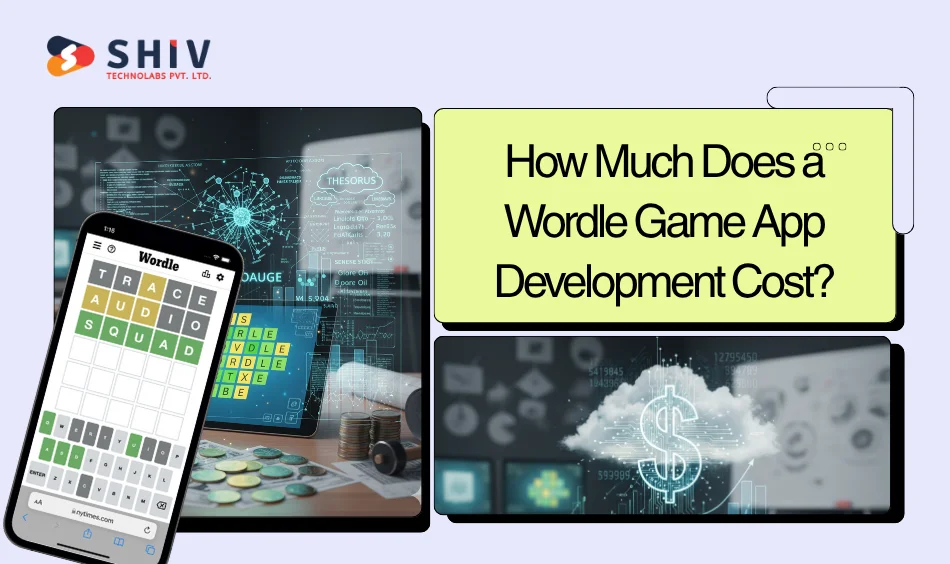
A Wordle-style app stays on the lower end of puzzle app pricing because it has fewer screens and light logic. A Wordscapes-like app or a multiplayer version requires more systems, so the cost rises.
Below is a clear breakdown.
# Word Game App Cost Summary
| App Type | Core Features Included | Estimated Cost (USD) |
| Wordle-Style App | Daily puzzle, color cues, hint rules, UI screens, basic admin setup, testing | $7,500 – $20,000 |
| Wordscapes-Style App | Level map, hundreds of puzzles, packs, difficulty rise, reward screens, streak logic | $15,000 – $50,000 |
| Multiplayer Word Puzzle App | Real-time sync, scoring, match screens, player history, advanced logic, testing | $25,000 – $70,000 |
# Quick Understanding
- Wordle-type = Lowest cost
- Wordscapes-type = Mid to high cost
- Multiplayer = Highest cost
The cost changes based on puzzle volume, modes, features, and the complexity of your game logic.
Which Factors Impact the Wordscapes and Wordle-like Puzzle App Development Cost?
The cost of building a word game app changes based on how deep the logic is, how many screens you want, and how much content the game carries. Even small features can shift the cost because puzzle apps depend on clean rules and stable responses. Below are the main factors that shape the final budget.
1. Game Format and Puzzle Style
Your app format affects the cost more than anything else.
Formats with lower cost:
- Single daily puzzle
- Simple guess-and-response flow
- Light word engine
Formats with higher cost:
- Level-based puzzle paths
- Puzzle packs
- Timed modes
- Multiplayer rounds
More formats mean more logic and testing.
2. Puzzle Engine Complexity
The puzzle engine selects words, filters them, and manages difficulty.
Cost rises when you add:
- Larger word libraries
- Difficulty grouping
- Hint variations
- Filters for unsafe terms
- Automated puzzle creation tools
A basic engine is quick to build, but a large engine needs more work.
3. Content Volume
Puzzle apps depend on content. More content = more time = higher cost.
Content that increases cost includes:
- Hundreds of levels
- Large packs
- Theme sets
- Daily puzzles for long periods
- Seasonal or special puzzle drops
A Wordle-style app needs far less content than a Wordscapes-style app.
4. Number of Screens and UI Depth
The more screens your app needs, the higher the cost.
Light UI (lower cost):
- Home
- Puzzle screen
- Settings
- Small streak panel
Deeper UI (higher cost):
- Level maps
- Theme screens
- Reward center
- Pack store
- Player stats
- Multiplayer lobby
Complex screens with interactions always add extra hours.
5. Interactions and Animations
Puzzle games must feel smooth. Even small animations need extra time.
Cost rises when you add:
- Color shifts
- Soft transitions
- Tile motions
- Confetti or celebration effects
- Character reactions
Basic feedback is quick. Advanced effects need more design and testing.
6. Device Support and Offline Play
Supporting more devices adds more testing. Offline play also requires proper storage logic.
Higher cost items include:
- Older device support
- Tablet layouts
- Full offline mode
- Sync between devices
These pieces improve player comfort but require more coding.
7. Monetization Setup
Puzzle apps often use both ads and in-app purchases. Each addition increases the cost.
Cost-adding components:
- Reward ads
- Remove-ads purchase
- Coin bundles
- Hint packs
- Puzzle pack purchases
Each item needs UI, logic, and testing time.
8. Testing and QA Hours
Word games look simple, but they need heavy testing because even one broken rule affects flow.
Testing increases cost when your app includes:
- Many levels
- Many puzzles
- Multiple modes
- Multiplayer logic
- Offline support
More moving parts = more test cycles.
Tech Stack for Word Game App Development
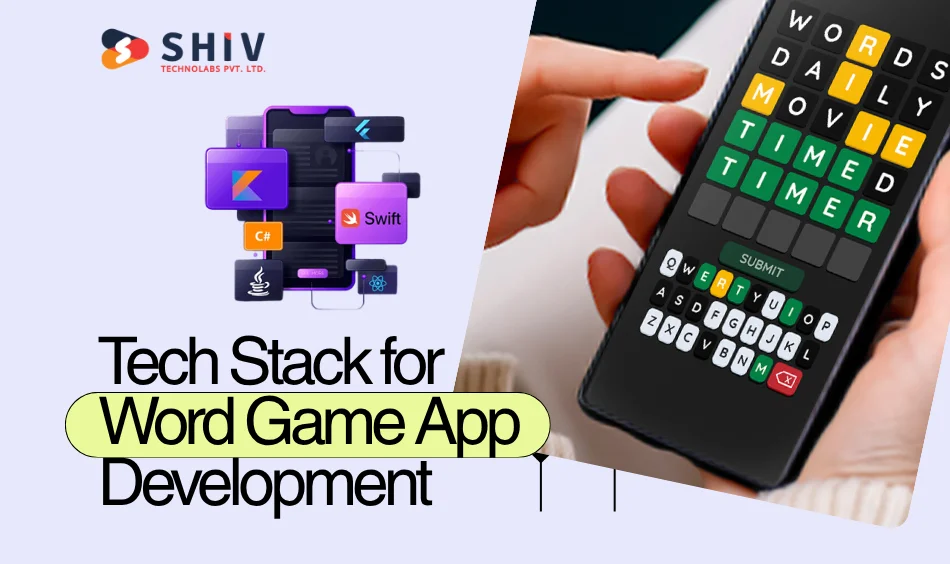
A word game app runs on light systems, but the stack must stay stable because puzzles depend on quick responses and clean logic. The right stack makes the app fast, easy to maintain, and capable of handling daily content drops without extra load.
# Frontend Tech Choices
The frontend handles all screens, inputs, and interactions. You need a framework that loads fast, supports soft animations, and offers stable performance on both iOS and Android.
Common picks:
- Flutter – smooth UI, fast builds, single codebase
- React Native – strong ecosystem, flexible layout control
- Swift / Kotlin – used for fully native builds if you want deep device-level control
Frontend speed matters because players expect instant reactions after each guess.
# Backend Tech Choices
Not all word games need a backend. Wordle-style apps may run without one. But if you plan daily drops, sync, or multiplayer, you need a stable backend.
Backend options:
- Node.js – light, fast, and great for real-time actions
- Python – perfect for puzzle logic, filters, and word processing
- Firebase – works well for sync, login, and simple data storage
Backends also store puzzle sets, hints, streaks, and level paths when needed.
# Database Choices
Puzzle apps need storage for word lists, filters, user progress, and daily tasks.
Reliable picks:
- PostgreSQL – ideal for large word libraries
- MongoDB – flexible structure for puzzle packs
- Firebase Firestore – great for quick reads and small apps
Choose based on puzzle volume and your update plan.
# Admin Panel & Puzzle Manager
An admin tool helps teams upload new puzzles, manage daily drops, and adjust difficulty.
Common stacks:
- React.js for clean dashboards
- Node.js or Python for puzzle tools
- Firebase for light admin tasks
This saves time when adding new content.
# Analytics and Tracking
Puzzle apps depend on user behavior patterns. You need light analytics to track drop-offs, streak usage, and puzzle difficulty.
Useful tools include:
- Google Analytics (screen flow)
- Firebase Analytics (engagement events)
- Mixpanel (deep behavior insights)
This helps you tune puzzle paths without guessing.
# Why This Stack Works
- Fast reactions after each guess
- Clean animations without heavy load
- Easy cross-platform builds
- Smooth updates for new puzzle packs
- Stable daily puzzle delivery
- Simple scaling for user growth
This stack supports Wordle-style and Wordscapes-style apps without unnecessary complexity.
How Shiv Technolabs Can Help You Build a Word Game App?
Creating a word game app needs strong puzzle logic, a clean UI flow, and a clear build plan. Shiv Technolabs follows a simple structure that helps founders shape a puzzle app with predictable progress and cost clarity.
# What Shiv Technolabs Contributes
- A structured plan for the word engine, difficulty setup, and safe-word filters
- Clear UI flows for grids, keyboards, hint paths, streaks, and puzzle packs
- Cross-platform app builds that work on both iOS and Android
- Efficient coding for daily puzzles, level maps, and reward systems
- Testing support for devices, slow networks, and offline play
- Guidance on ad placement, purchase setup, and smooth interactions
# Why This Matters
Puzzle apps depend on logic and clean responses. Shiv Technolabs focuses on clarity in each part—puzzle rules, screen flow, and long-term content rhythm—so the final app feels stable and easy to expand.
# Support Beyond the Initial Build
- Adding new puzzle packs
- Extending streak systems
- Improving animations
- Updating hints or difficulty
- Strengthening device compatibility
This helps the app stay active even after launch.
Conclusion
Word puzzle apps stay strong because they fit short sessions and offer calm, satisfying tasks. A clear idea, a stable word engine, and a simple UI flow form the base of every good puzzle app. Costs shift based on puzzle volume, screens, modes, and logic depth, but planning each part early helps keep the build predictable.
If you aim to create an app similar to Wordle or Wordscapes, focus on clean rules, light visuals, and a steady content rhythm. These elements shape long-term engagement and help the app grow without heavy production demands. With the right structure and clear decisions at each step, a word game can reach users across many routines and remain active for a long time. Contact Shiv Technolabs now!
Frequently Asked Questions About the Cost of Word Game App Development
Below are the most common questions founders ask when planning a Wordle-like or Wordscapes-style app.
1. What is the starting cost to build a basic Wordle-style app?
A simple Wordle-style app with a daily puzzle, color cues, hint rules, and core screens generally starts near $7,500 and can rise based on added features.
2. Why does a Wordscapes-style app cost more than a Wordle-style app?
A Wordscapes-style app needs many levels, puzzle packs, a difficulty path, and more UI screens. This increases design hours, puzzle planning, and testing, which raises the cost.
3. Does the size of the word library affect the cost?
Yes. Large dictionaries need filters, sorting, difficulty groups, and safe-word checks. More logic means more work, which increases the cost.
4. How much does it cost to add a level map?
A level map adds design patterns, movement logic, and progress tracking. This usually adds $1,500 to $6,000, depending on complexity.
5. Does multiplayer affect the total cost?
Yes. Multiplayer adds match flow, sync rules, scoring logic, and separate screens. These pieces push the cost higher because each round requires real-time checks.
6. How much does testing impact the budget?
Testing plays a huge role in puzzle apps. Each puzzle, rule, and color cue must work correctly. More modes or levels require more test cycles, increasing the total cost.
7. Do animations increase the development cost?
Small animations add a minor cost. Larger animations—such as tile motion, celebrations, or level transition effects—add more time and increase the budget.
8. How much does it cost to add offline play?
Offline play requires local storage, extra logic, and more testing on different devices. This usually adds $800 to $3,000.
9. Are in-app purchases expensive to set up?
Not usually. Simple packs like hints, coins, or remove-ads upgrades take moderate effort. However, stores with many items cost more due to added screens and logic.
10. How long does it take to build a Wordle-like app?
A basic version may take 3–5 weeks. A deeper version with more screens can take 8–12 weeks, depending on puzzle volume.
11. Does publishing on Google Play or the App Store add cost?
Publishing itself is simple. But both stores require assets, screenshots, and testing. These tasks can add minor one-time expenses.
12. How much does ongoing support cost?
Support depends on how often you release new puzzles or features. Light support stays low. Heavy content drops or long-term expansions cost more.

